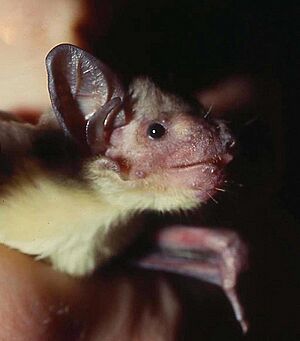African yellow bat facts for kids
Quick facts for kids African yellow bat |
|
|---|---|
 |
|
| Conservation status | |
| Scientific classification |
The African yellow bat (Scotophilus dinganii) is a type of bat that belongs to the vesper bat family. It's also known by other names like the African yellow house bat or yellow-bellied house bat. This bat is one of about fifteen different species in its group, called Scotophilus.
Contents
What Does the African Yellow Bat Look Like?
The African yellow bat is a medium-sized bat. It has a snout that looks a bit like a dog's. Its back is light brown, and its belly is a bright yellow. You can easily see its eyes, and its snout is short and wide.
Its wings can be olive, grey, or even red. The skin between its legs, called the interfemoral membrane, is brown and a little see-through. This bat is about 130 millimeters (about 5 inches) long from head to tail. Its forearm, which is part of its wing, measures 50–58 millimeters. On average, it weighs around 23 grams, which is about the same as a few quarters.
Where Do African Yellow Bats Live?
You can find the African yellow bat across a large part of Sub-Saharan Africa. They live from countries like Senegal and The Gambia in the west. Their range extends east to Djibouti, Eritrea, and Somalia. They also live south all the way to South Africa, reaching the Eastern Cape region.
What Kind of Places Do They Call Home?
African yellow bats prefer to live in savanna areas. These are grassy plains with scattered trees. They can often be found close to where people live. This is because they like to roost, or rest, inside houses. They might roost alone or in small groups.
How Do African Yellow Bats Live?
African yellow bats have interesting habits. In southern Africa, they usually mate during the autumn months. The females then give birth to twins in late November or early December, which is springtime there. The young bats grow up quickly. Female bats stop feeding their babies within just a few weeks after they are born. These bats tend to stay loyal to their chosen roosting spots.
Where Do They Sleep During the Day?
During the day, African yellow bats rest in hollows or cracks in large trees. Their groups are usually small, with rarely more than 12 bats together. They often find quiet, hidden spots in cracks within walls and roofs of buildings. This is why they are often found in suburban areas. People living in these houses usually don't even know the bats are there because they are so quiet.
When Do They Hunt?
African yellow bats typically don't leave their roost until it's completely dark outside. They usually feed until they are full, which takes about two hours. After hunting, they return to their roost. Sometimes, they share their roosts with a smaller bat called the Cape serotine. You can tell the African yellow bat apart because it has larger wings and flies faster.
What Do They Eat?
These bats mostly eat beetles. But they also hunt other insects. Their diet includes plant-sucking bugs, flies, flying termites, moths, and lacewings.


